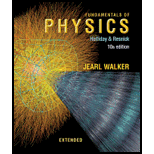
Fundamentals of Physics Extended
10th Edition
ISBN: 9781118230725
Author: David Halliday, Robert Resnick, Jearl Walker
Publisher: Wiley, John & Sons, Incorporated
expand_more
expand_more
format_list_bulleted
Concept explainers
Textbook Question
Chapter 32, Problem 55P
Earth has a magnetic dipole moment of 8.0 × 1022 J/T. (a) What current would have to be produced in a single turn of wire extending around Earth at its geomagnetic equator if we wished to set up such a dipole? Could such an arrangement be used to cancel out Earth's magnetism (b) at points in space well above Earth's surface or (c) on Earth's surface?
Expert Solution & Answer
Want to see the full answer?
Check out a sample textbook solution
Chapter 32 Solutions
Fundamentals of Physics Extended
Ch. 32 - Figure 32-19a shows a capacitor, with circular...Ch. 32 - Prob. 2QCh. 32 - Prob. 3QCh. 32 - Figure 32-22a shows a pair of opposite spin...Ch. 32 - An electron in an external magnetic field Bext has...Ch. 32 - Prob. 6QCh. 32 - Figure 32-23 shows a face-on view of one of the...Ch. 32 - Prob. 8QCh. 32 - Replace the current loops of Question 8 and Fig....Ch. 32 - Prob. 10Q
Ch. 32 - Figure 32-25 represents three rectangular samples...Ch. 32 - Prob. 12QCh. 32 - Prob. 1PCh. 32 - Prob. 2PCh. 32 - Prob. 3PCh. 32 - Prob. 4PCh. 32 - Prob. 5PCh. 32 - Prob. 6PCh. 32 - Prob. 7PCh. 32 - GO Nonuniform electric flux. Figure 32-30 shows a...Ch. 32 - Prob. 9PCh. 32 - Prob. 10PCh. 32 - Prob. 11PCh. 32 - Prob. 12PCh. 32 - Prob. 13PCh. 32 - Prob. 14PCh. 32 - Prob. 15PCh. 32 - Prob. 16PCh. 32 - Prob. 17PCh. 32 - Prob. 18PCh. 32 - Prob. 19PCh. 32 - Prob. 20PCh. 32 - Prob. 21PCh. 32 - Prob. 22PCh. 32 - Prob. 23PCh. 32 - The magnitude of the electric field between the...Ch. 32 - Prob. 25PCh. 32 - Prob. 26PCh. 32 - Prob. 27PCh. 32 - GO Figure 32-35a shows the current i that is...Ch. 32 - Prob. 29PCh. 32 - Assume the average value of the vertical component...Ch. 32 - In New Hampshire the average horizontal component...Ch. 32 - Figure 32-37a is a one-axis graph along which two...Ch. 32 - SSM WWWIf an electron in an atom has an orbital...Ch. 32 - Prob. 34PCh. 32 - What is the measured component of the orbital...Ch. 32 - Prob. 36PCh. 32 - Prob. 37PCh. 32 - Assume that an electron of mass m and charge...Ch. 32 - A sample of the paramagnetic salt to which the...Ch. 32 - A sample of the paramagnetic salt to which the...Ch. 32 - Prob. 41PCh. 32 - Prob. 42PCh. 32 - Prob. 43PCh. 32 - Figure 32-39 gives the magnetization curve for a...Ch. 32 - Prob. 45PCh. 32 - You place a magnetic compass on a horizontal...Ch. 32 - SSM ILW WWW The magnitude of the magnetic dipole...Ch. 32 - The magnitude of the dipole moment associated with...Ch. 32 - SSMThe exchange coupling mentioned in Module 32-8...Ch. 32 - Prob. 50PCh. 32 - Prob. 51PCh. 32 - Prob. 52PCh. 32 - Prob. 53PCh. 32 - Using the approximations given in Problem 61, find...Ch. 32 - Earth has a magnetic dipole moment of 8.0 1022...Ch. 32 - A charge q is distributed uniformly around a thin...Ch. 32 - A magnetic compass has its needle, of mass 0.050...Ch. 32 - Prob. 58PCh. 32 - Prob. 59PCh. 32 - Prob. 60PCh. 32 - SSMThe magnetic field of Earth can be approximated...Ch. 32 - Prob. 62PCh. 32 - Prob. 63PCh. 32 - A sample of the paramagnetic salt to which the...Ch. 32 - Prob. 65PCh. 32 - Prob. 66PCh. 32 - In Fig. 32-42, a parallel-plate capacitor is being...Ch. 32 - What is the measured component of the orbital...Ch. 32 - Prob. 69PCh. 32 - Prob. 70PCh. 32 - Prob. 71PCh. 32 - Prob. 72PCh. 32 - SSM If an electron in an atom has orbital angular...Ch. 32 - Prob. 74PCh. 32 - Prob. 75PCh. 32 - What are the measured components of the orbital...
Additional Science Textbook Solutions
Find more solutions based on key concepts
64. You have a device that needs a voltage reference of 3.0 V, but you have only a 9.0 V battery. Fortunately, ...
College Physics: A Strategic Approach (3rd Edition)
The angle between vectors.
Mathematical Methods in the Physical Sciences
38. A 3.0-cm-tall object is 15 cm in front of a concave mirror that has a 25 cm focal length.
College Physics: A Strategic Approach (4th Edition)
Find the change in u for carbon dioxide between 600 K and 1200 K using (a) Table A.5. (b) Table A.6 at the aver...
EBK FUNDAMENTALS OF THERMODYNAMICS, ENH
* Equation Jeopardy 2 The equations below describe one or more physical processes Solve the equations for the u...
College Physics
65. Blocks of mass m1 and m2 are connected by a massless string that passes over the pulley in FIGURE P12.65. T...
Physics for Scientists and Engineers: A Strategic Approach, Vol. 1 (Chs 1-21) (4th Edition)
Knowledge Booster
Learn more about
Need a deep-dive on the concept behind this application? Look no further. Learn more about this topic, physics and related others by exploring similar questions and additional content below.Similar questions
- Rank the magnitudes of' the forces exerted on the following particles from largest to smallest. In your ranking, display any cases of equality, (a) an electron moving at 1 Mm/s perpendicular to a 1-mT magnetic field (b) an electron moving at 1 Mm/s parallel to a 1-mT magnetic field (c) an electron moving at 2 Mm/s perpendicular to a 1-mT magnetic field (d) a proton moving at 1 Mm/s perpendicular to a 1-mT magnetic field (e) a proton moving at 1 Mm/s at a 45 angle to a 1-mT magnetic fieldarrow_forwardConsider an electron rotating in a circular orbit of radius r. Show that the magnitudes of the magnetic dipole moment and the angular momentum L of the electron are related by: = L=e2marrow_forwardIf a charged particle moves in a straight line, can you conclude that there is no magnetic field present?arrow_forward
- A cosmic-ray proton in interstellar space has an energy of 10.0 MeV and executes a circular orbit having a radius equal to that of Mercury’s orbit around the Sun (5.80 × 1010 m). What is the magnetic field in that region of space?arrow_forwardWhat magnetic field is required in order to confine a proton moving with a speed of 4.0 × 106 m/s to a circular orbit of radius 10 cm?arrow_forwardDoes increasing the magnitude of a uniform magnetic field through which a charge is traveling necessarily mean increasing the magnetic force on the charge? Does changing the direction of the field necessarily mean a change in the force on the charge?arrow_forward
- A circular coil of radius 5.0 cm is wound with five turns and carries a current of 5.0 A. If the coil is placed in a uniform magnetic field of strength 5.0 T, what is the maximum torque on it?arrow_forwardWithin the green dashed circle shown in Figure P23.28, the magnetic field changes with time according to the expression B = 2.00t3 − 4.00t2 + 0.800, where B is in teslas, t is in seconds, and R = 2.50 cm. When t = 2.00 s, calculate (a) the magnitude and (b) the direction of the force exerted on an electron located at point P1, which is at a distance r1 = 5.00 cm from the center of the circular field region. (c) At what instant is this force equal to zero?arrow_forwardA proton (charge + e, mass mp), a deuteron (charge + e, mass 2mp), and an alpha particle (charge +2e, mass 4mp) are accelerated from rest through a common potential difference V. Each of the particles enters a uniform magnetic field B, with its velocity in a direction perpendicular to B. The proton moves in a circular path of radius rp. In terms of rp, determine (a) the radius rd of the circular orbit for the deuteron and (b) the radius ra for the alpha particle.arrow_forward
- Is the magnetic field inside a toroid completely uniform? Almost uniform?arrow_forwardA proton (charge +e, mass mp), a deuteron (charge +e, mass 2mp), and an alpha particle (charge +2e, mass 4mp) are accelerated from rest through a common potential difference V. Each of the particles enters a uniform magnetic field B, with its velocity in a direction perpendicular to B. The proton moves in a circular path of radius p. In terms of p, determine (a) the radius rd of the circular orbit for the deuteron and (b) the radius r for the alpha particle.arrow_forwardA horizontal power line of length 58 m carries a current of 2.2 kA as shown in Figure P19.34. Earths magnetic field at this location has a magnitude equal to 5.0 105. T and makes an angle of 65 with the power line. Find the magnitude and direction of the magnetic force on the power line. Figure P19.34arrow_forward
arrow_back_ios
SEE MORE QUESTIONS
arrow_forward_ios
Recommended textbooks for you
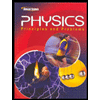 Glencoe Physics: Principles and Problems, Student...PhysicsISBN:9780078807213Author:Paul W. ZitzewitzPublisher:Glencoe/McGraw-Hill
Glencoe Physics: Principles and Problems, Student...PhysicsISBN:9780078807213Author:Paul W. ZitzewitzPublisher:Glencoe/McGraw-Hill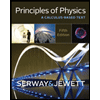 Principles of Physics: A Calculus-Based TextPhysicsISBN:9781133104261Author:Raymond A. Serway, John W. JewettPublisher:Cengage Learning
Principles of Physics: A Calculus-Based TextPhysicsISBN:9781133104261Author:Raymond A. Serway, John W. JewettPublisher:Cengage Learning Physics for Scientists and Engineers, Technology ...PhysicsISBN:9781305116399Author:Raymond A. Serway, John W. JewettPublisher:Cengage Learning
Physics for Scientists and Engineers, Technology ...PhysicsISBN:9781305116399Author:Raymond A. Serway, John W. JewettPublisher:Cengage Learning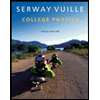 College PhysicsPhysicsISBN:9781285737027Author:Raymond A. Serway, Chris VuillePublisher:Cengage Learning
College PhysicsPhysicsISBN:9781285737027Author:Raymond A. Serway, Chris VuillePublisher:Cengage Learning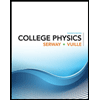 College PhysicsPhysicsISBN:9781305952300Author:Raymond A. Serway, Chris VuillePublisher:Cengage Learning
College PhysicsPhysicsISBN:9781305952300Author:Raymond A. Serway, Chris VuillePublisher:Cengage Learning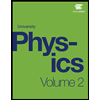

Glencoe Physics: Principles and Problems, Student...
Physics
ISBN:9780078807213
Author:Paul W. Zitzewitz
Publisher:Glencoe/McGraw-Hill

Principles of Physics: A Calculus-Based Text
Physics
ISBN:9781133104261
Author:Raymond A. Serway, John W. Jewett
Publisher:Cengage Learning

Physics for Scientists and Engineers, Technology ...
Physics
ISBN:9781305116399
Author:Raymond A. Serway, John W. Jewett
Publisher:Cengage Learning

College Physics
Physics
ISBN:9781285737027
Author:Raymond A. Serway, Chris Vuille
Publisher:Cengage Learning

College Physics
Physics
ISBN:9781305952300
Author:Raymond A. Serway, Chris Vuille
Publisher:Cengage Learning

Magnets and Magnetic Fields; Author: Professor Dave explains;https://www.youtube.com/watch?v=IgtIdttfGVw;License: Standard YouTube License, CC-BY